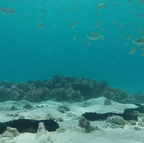1:00 BIODIVERSITY
What could we learn from watching 1 hour of footage recorded underwater with no people around?
A lot.
This project puts GoPro cameras in front of individual coral heads for an hour with the goal of documenting any and everything caught on camera during filming. The footage alone doesn't tell us a ton, but over time we will get a really interesting picture of biodiversity as we analyze an hour of footage year after year after year. The Marshall Islands is filled with beautiful, vibrant corals streaming with fish. Will it always be so? This project will allow us to document population sizes, number of different organisms and species, as well as general behaviors we see. The videos will be posted here, as well as the infographics after we analyze the activity.
If you want to join, put a hidden camera on your own reef...or river...or tundra...or anywhere. Let's start documenting our world's biodiversity together.










Here are the results for the first site, known as Toblar:
Species: 14
Organisms: 620
Here are the results for the second location, known as Lorac:
Species: 12
Organisms: 239
Here are the results for the third spot, known as S.W.O.B.I.:
Species: 9
Organisms: 206
What did we find?
What species did we observe?
1. The most common fish was the blue blanquillo, also known as the blue damsel.
2. Next were the gold-lined sea bream, long-finned drummer, blunt-head wrasse, and speckled butterfly fish
3.Surgeon fish, peacock grouper, goat fish, trigger fish, and parrot fish made up the next largest species represented.
4. Appearances by a File Fish, Stick Fish, and Red Snapper, and a Sweet Lips were highlights in the study as well!

What is 1:00 Biodiversity?
This blog describes our project and what we did.

Why is Biodiversity Important?
Why should we be measuring levels of biodiversity and what can we learn from them over time?

What did we find?
What are the levels of biodiversity in the lagoon waters of the Marshall Islands?
HYDRA

How is Biodiversity Changing?
This was the first year for collecting data. What do we think we will see and hope to see in this area in the future?
SANTORINI

What impacts levels of biodiversity?
Why might we find more or less biodiversity in some places over time? That is what we will explore in this article.
MYKONOS

What can we learn?
This blog dives into the conclusions we make after our first year conducting this research.













